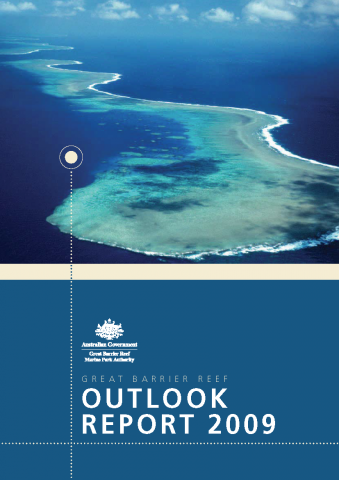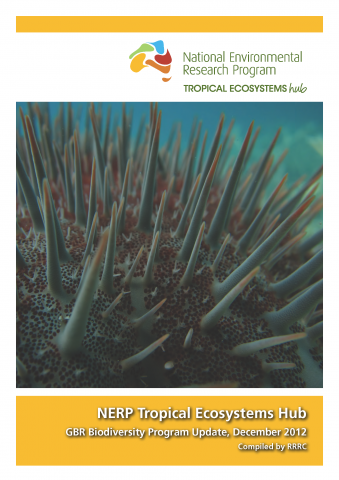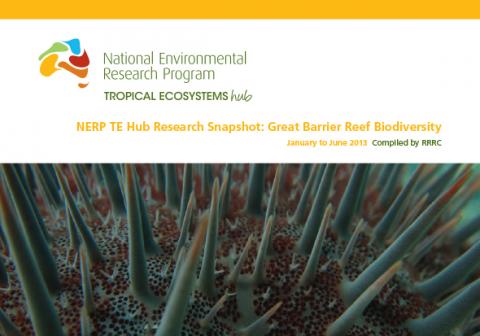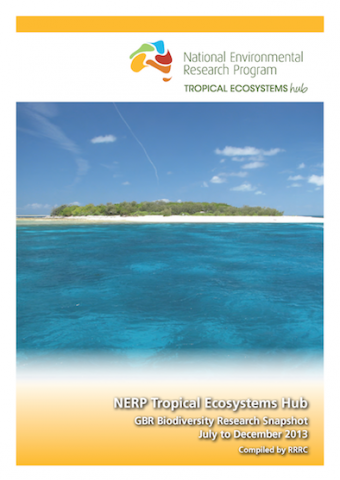Resources
 Geoff Jones (JCU); Dave Williamson, Hugo Harrison, Jeff Leis, Lou Mason, Severine Choukroun, Michael Berumen, Jessica Hopf, Sean Connolly, Glenn Almany, Ashley Frisch. Protecting the next generation: do marine reserves and size limits supplement recruitment of coral trout. Wednesday 8th May 2013.
Geoff Jones (JCU); Dave Williamson, Hugo Harrison, Jeff Leis, Lou Mason, Severine Choukroun, Michael Berumen, Jessica Hopf, Sean Connolly, Glenn Almany, Ashley Frisch. Protecting the next generation: do marine reserves and size limits supplement recruitment of coral trout. Wednesday 8th May 2013.
 The Great Barrier Reef Outlook Report 2009 is a stock-take of the Great Barrier Reef, its management and its future.
The Great Barrier Reef Outlook Report 2009 is a stock-take of the Great Barrier Reef, its management and its future.
The aim of the Outlook Report is to provide information about:
- The condition of the ecosystem of the Great Barrier Reef Region (including the ecosystem outside the Region where it affects the Region);
• Social and economic factors influencing the Great Barrier Reef ecosystem;
• Management effectiveness of the Great Barrier Reef; and
• Risk-based assessment of the long-term outlook for the Region.
The Report underpins decision-making for the long term protection of the Great Barrier Reef. It was prepared by the GBRMPA based on the best available information and was independently peer reviewed. Many people contributed to the development of the Outlook Report including:
• Australian and Queensland Government agencies
• Leading Great Barrier Reef scientists and researchers
• Industry representatives
• Advisory committees
• Members of regional communities and the public.
The publication of an Outlook Report was a key recommendation of the review of the Great Barrier Reef Marine Park Act 1975. A report is to be prepared every five years and given to the Minister for Sustainability, Environment, Water, Population and Communities for tabling in both houses of the Australian Parliament.
The Great Barrier Reef Outlook Report 2009 is the first of these reports.
 An update brochure of what's going on with the NERP Tropical Ecosystems Hub Great Barrier Reef Biodiversity projects.
An update brochure of what's going on with the NERP Tropical Ecosystems Hub Great Barrier Reef Biodiversity projects.
 A snapshot of the research progress within the Great Barrier Reef Biodiversity node for January to June 2013.
A snapshot of the research progress within the Great Barrier Reef Biodiversity node for January to June 2013.
 A snapshot of the research progress within the Great Barrier Reef Biodiversity node for July to December 2013.
A snapshot of the research progress within the Great Barrier Reef Biodiversity node for July to December 2013.
Harrison HB, Williamson DH, Evans RD, Almany GR, Thorrold SR, Russ GR, Feldheim KA, van Herwerden L, Planes S, Srinivasan M, Berumen ML, Jones GP (2012). Larval Export From Marine Reserves and the Recruitment Benefit for Fish and Fisheries. Current Biology.

 Previous research has shown compelling evidence for green zones as an effective conservation and fisheries management tool. However, the scale over which reserves benefit fisheries by providing stock and the degree to which they contribute to maintaining fish populations in the long term needs to be evaluated.
Previous research has shown compelling evidence for green zones as an effective conservation and fisheries management tool. However, the scale over which reserves benefit fisheries by providing stock and the degree to which they contribute to maintaining fish populations in the long term needs to be evaluated.

Journal of Environmental Management
Cvitanovic, C., Wilson, S.K., Fulton, C.J., Almany, G.R., Anderson, P., Babcock, R.C., Ban, N.C., Beeden, R.J., Beger, M., Cinner, J., Dobbs, K., Evans, L.S., Farnham, A., Friedman, K.J., Gale, K., Gladstone, W., Grafton, Q., Graham, N.A.J., Gudge, S., Harrison, P.L., Holmes, T.H., Johnstone, N., Jones, G.P., Jordan, A., Kendrick, A.J., Klein, C.J., Little, L.R., Malcolm, H.A., Morris, D., Possingham, H.P., Prescott, J., Pressey, R.L., Skilleter, G.A., Simpson, C., Waples, K., Wilson, D., Williamson, D.H. (2012) Critical research needs for managing coral reef marine protected areas: Perspectives of academics and managers. Journal of Environmental Management. 114, 84-91 [doi:10.1016/j.jenvman.2012.10.051].

Marine Ecology Progress Series
Wen, C.K.C., Almany, G.R., Williamson, D.H., Pratchett, M.S., Jones, G.P. (2012) Evaluating the effects of marine reserves on diet, prey availability and prey selection by juvenile predatory fishes. Marine Ecology Progress Series. 469, 133-144 [doi:10.3354/meps09949].
* Funded by DEWHA (MTSRF), GBRMPA and JCU



